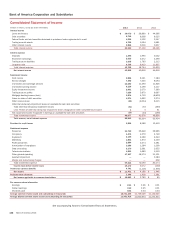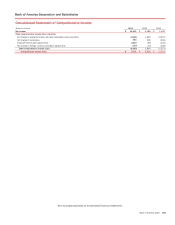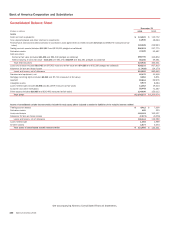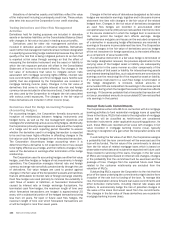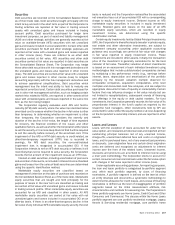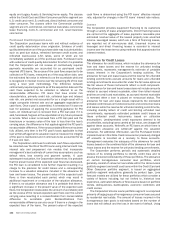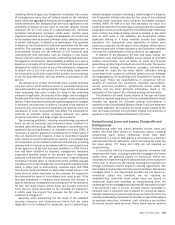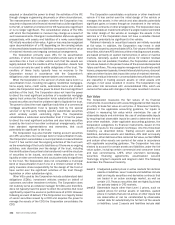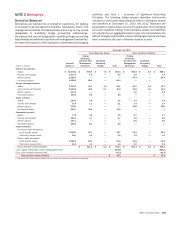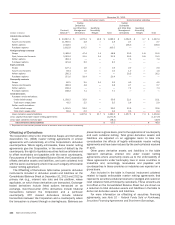Bank of America 2013 Annual Report Download - page 158
Download and view the complete annual report
Please find page 158 of the 2013 Bank of America annual report below. You can navigate through the pages in the report by either clicking on the pages listed below, or by using the keyword search tool below to find specific information within the annual report.156 Bank of America 2013
Valuations of derivative assets and liabilities reflect the value
of the instrument including counterparty credit risk. These values
also take into account the Corporation’s own credit standing.
Trading Derivatives and Other Risk Management
Activities
Derivatives held for trading purposes are included in derivative
assets or derivative liabilities on the Consolidated Balance Sheet
with changes in fair value included in trading account profits.
Derivatives used for other risk management activities are
included in derivative assets or derivative liabilities. Derivatives
used in other risk management activities have not been designated
in a qualifying accounting hedge relationship because they did not
qualify or the risk that is being mitigated pertains to an item that
is reported at fair value through earnings so that the effect of
measuring the derivative instrument and the asset or liability to
which the risk exposure pertains will offset in the Consolidated
Statement of Income to the extent effective. The changes in the
fair value of derivatives that serve to mitigate certain risks
associated with mortgage servicing rights (MSRs), interest rate
lock commitments (IRLCs) and first mortgage loans held-for-sale
(LHFS) that are originated by the Corporation are recorded in
mortgage banking income (loss). Changes in the fair value of
derivatives that serve to mitigate interest rate risk and foreign
currency risk are included in other income (loss). Credit derivatives
are also used by the Corporation to mitigate the risk associated
with various credit exposures. The changes in the fair value of
these derivatives are included in other income (loss).
Derivatives Used For Hedge Accounting Purposes
(Accounting Hedges)
For accounting hedges, the Corporation formally documents at
inception all relationships between hedging instruments and
hedged items, as well as the risk management objectives and
strategies for undertaking various accounting hedges. Additionally,
the Corporation primarily uses regression analysis at the inception
of a hedge and for each reporting period thereafter to assess
whether the derivative used in a hedging transaction is expected
to be and has been highly effective in offsetting changes in the
fair value or cash flows of a hedged item or forecasted transaction.
The Corporation discontinues hedge accounting when it is
determined that a derivative is not expected to be or has ceased
to be highly effective as a hedge, and then reflects changes in fair
value of the derivative in earnings after termination of the hedge
relationship.
The Corporation uses its accounting hedges as either fair value
hedges, cash flow hedges or hedges of net investments in foreign
operations. The Corporation manages interest rate and foreign
currency exchange rate sensitivity predominantly through the use
of derivatives. Fair value hedges are used to protect against
changes in the fair value of the Corporation’s assets and liabilities
that are attributable to interest rate or foreign exchange volatility.
Cash flow hedges are used primarily to minimize the variability in
cash flows of assets or liabilities, or forecasted transactions
caused by interest rate or foreign exchange fluctuations. For
terminated cash flow hedges, the maximum length of time over
which forecasted transactions are hedged is approximately 25
years, with a substantial portion of the hedged transactions being
less than 10 years. For open or future cash flow hedges, the
maximum length of time over which forecasted transactions are
or will be hedged is less than seven years.
Changes in the fair value of derivatives designated as fair value
hedges are recorded in earnings, together and in the same income
statement line item with changes in the fair value of the related
hedged item. Changes in the fair value of derivatives designated
as cash flow hedges are recorded in accumulated other
comprehensive income (OCI) and are reclassified into the line item
in the income statement in which the hedged item is recorded in
the same period the hedged item affects earnings. Hedge
ineffectiveness and gains and losses on the excluded component
of a derivative in assessing hedge effectiveness are recorded in
earnings in the same income statement line item. The Corporation
records changes in the fair value of derivatives used as hedges
of the net investment in foreign operations, to the extent effective,
as a component of accumulated OCI.
If a derivative instrument in a fair value hedge is terminated or
the hedge designation removed, the previous adjustments to the
carrying value of the hedged asset or liability are subsequently
accounted for in the same manner as other components of the
carrying value of that asset or liability. For interest-earning assets
and interest-bearing liabilities, such adjustments are amortized to
earnings over the remaining life of the respective asset or liability.
If a derivative instrument in a cash flow hedge is terminated or
the hedge designation is removed, related amounts in
accumulated OCI are reclassified into earnings in the same period
or periods during which the hedged forecasted transaction affects
earnings. If it becomes probable that a forecasted transaction will
not occur, any related amounts in accumulated OCI are reclassified
into earnings in that period.
Interest Rate Lock Commitments
The Corporation enters into IRLCs in connection with its mortgage
banking activities to fund residential mortgage loans at specified
times in the future. IRLCs that relate to the origination of mortgage
loans that will be classified as held-for-sale are considered
derivative instruments under applicable accounting guidance. As
such, these IRLCs are recorded at fair value with changes in fair
value recorded in mortgage banking income (loss), typically
resulting in recognition of a gain when the Corporation enters into
IRLCs.
In estimating the fair value of an IRLC, the Corporation assigns
a probability that the loan commitment will be exercised and the
loan will be funded. The fair value of the commitments is derived
from the fair value of related mortgage loans which is based on
observable market data and includes the expected net future cash
flows related to servicing of the loans. Changes in the fair value
of IRLCs are recognized based on interest rate changes, changes
in the probability that the commitment will be exercised and the
passage of time. Changes from the expected future cash flows
related to the customer relationship are excluded from the
valuation of IRLCs.
Outstanding IRLCs expose the Corporation to the risk that the
price of the loans underlying the commitments might decline from
inception of the rate lock to funding of the loan. To manage this
risk, the Corporation utilizes forward loan sales commitments and
other derivative instruments, including interest rate swaps and
options, to economically hedge the risk of potential changes in
the value of the loans that would result from the commitments.
The changes in the fair value of these derivatives are recorded in
mortgage banking income (loss).




